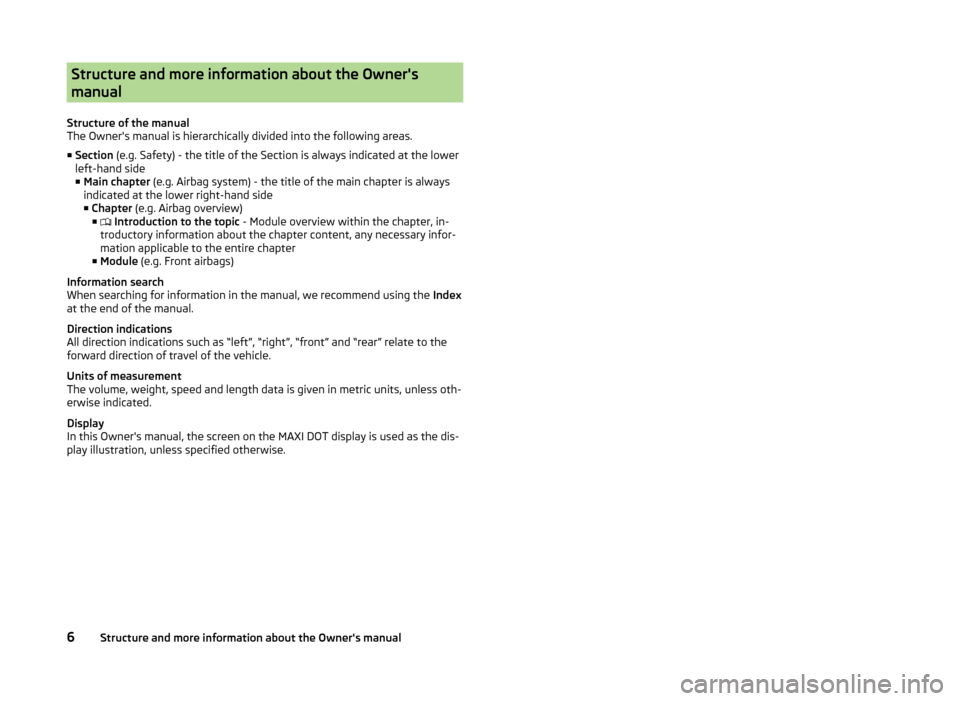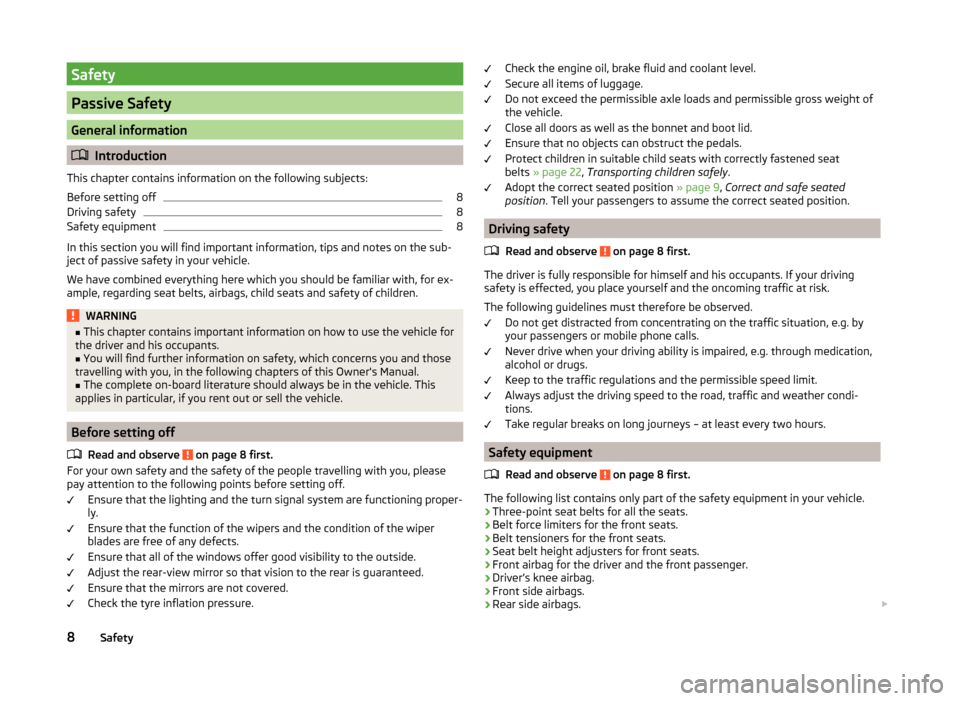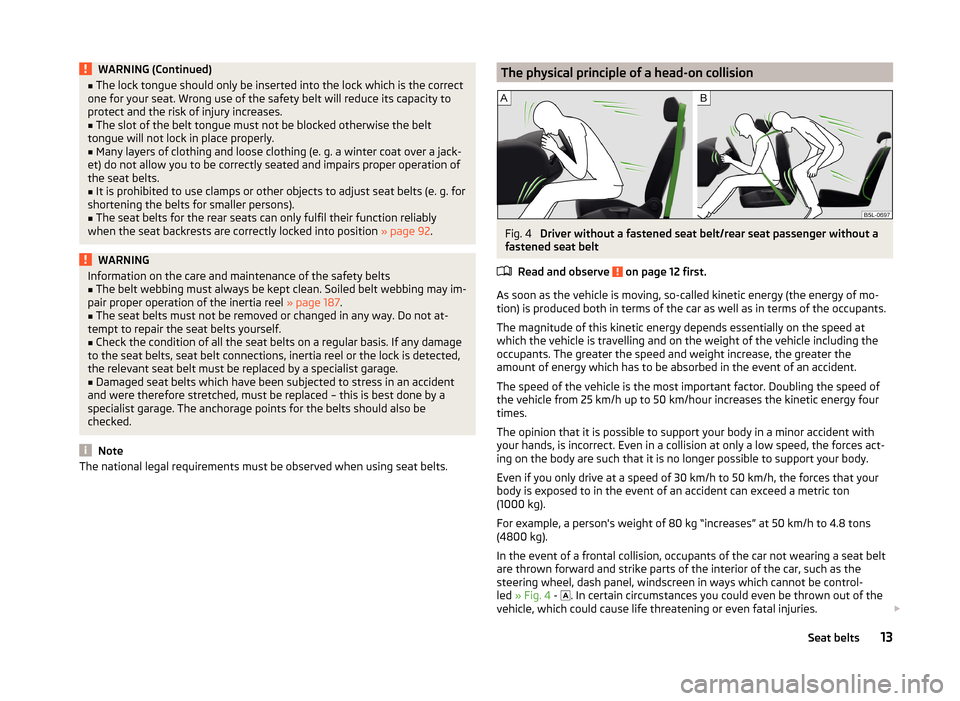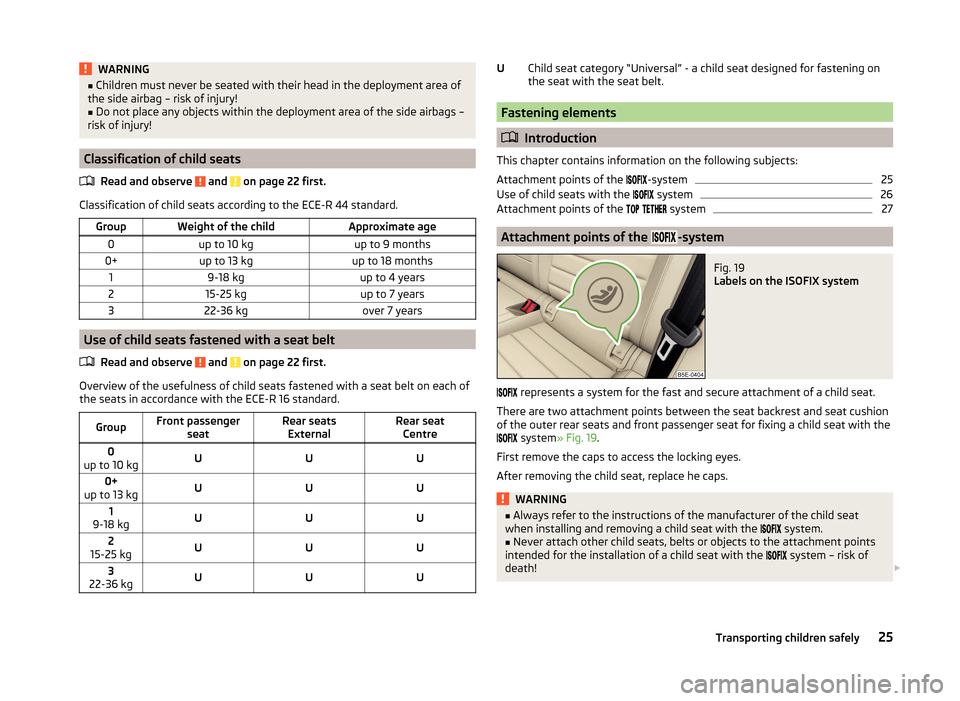weight SKODA OCTAVIA 2014 3.G / (5E) Owner's Manual
[x] Cancel search | Manufacturer: SKODA, Model Year: 2014, Model line: OCTAVIA, Model: SKODA OCTAVIA 2014 3.G / (5E)Pages: 280, PDF Size: 35.53 MB
Page 9 of 280

Structure and more information about the Owner's
manual
Structure of the manual
The Owner's manual is hierarchically divided into the following areas.
■ Section (e.g. Safety) - the title of the Section is always indicated at the lower
left-hand side
■ Main chapter (e.g. Airbag system) - the title of the main chapter is always
indicated at the lower right-hand side
■ Chapter (e.g. Airbag overview)
■ Introduction to the topic
- Module overview within the chapter, in-
troductory information about the chapter content, any necessary infor-
mation applicable to the entire chapter
■ Module (e.g. Front airbags)
Information search
When searching for information in the manual, we recommend using the Index
at the end of the manual.
Direction indications
All direction indications such as “left”, “right”, “front” and “rear” relate to the forward direction of travel of the vehicle.
Units of measurement
The volume, weight, speed and length data is given in metric units, unless oth-
erwise indicated.
Display
In this Owner's manual, the screen on the MAXI DOT display is used as the dis-
play illustration, unless specified otherwise.6Structure and more information about the Owner's manual
Page 11 of 280

Safety
Passive Safety
General information
Introduction
This chapter contains information on the following subjects:
Before setting off
8
Driving safety
8
Safety equipment
8
In this section you will find important information, tips and notes on the sub-
ject of passive safety in your vehicle.
We have combined everything here which you should be familiar with, for ex-
ample, regarding seat belts, airbags, child seats and safety of children.
WARNING■ This chapter contains important information on how to use the vehicle for
the driver and his occupants.■
You will find further information on safety, which concerns you and those
travelling with you, in the following chapters of this Owner's Manual.
■
The complete on-board literature should always be in the vehicle. This
applies in particular, if you rent out or sell the vehicle.
Before setting off
Read and observe
on page 8 first.
For your own safety and the safety of the people travelling with you, please
pay attention to the following points before setting off.
Ensure that the lighting and the turn signal system are functioning proper-
ly.
Ensure that the function of the wipers and the condition of the wiper
blades are free of any defects.
Ensure that all of the windows offer good visibility to the outside.
Adjust the rear-view mirror so that vision to the rear is guaranteed.
Ensure that the mirrors are not covered.
Check the tyre inflation pressure.
Check the engine oil, brake fluid and coolant level.
Secure all items of luggage.
Do not exceed the permissible axle loads and permissible gross weight of
the vehicle.
Close all doors as well as the bonnet and boot lid.
Ensure that no objects can obstruct the pedals.
Protect children in suitable child seats with correctly fastened seat
belts » page 22 , Transporting children safely .
Adopt the correct seated position » page 9, Correct and safe seated
position . Tell your passengers to assume the correct seated position.
Driving safety
Read and observe
on page 8 first.
The driver is fully responsible for himself and his occupants. If your driving
safety is effected, you place yourself and the oncoming traffic at risk.
The following guidelines must therefore be observed. Do not get distracted from concentrating on the traffic situation, e.g. by
your passengers or mobile phone calls.
Never drive when your driving ability is impaired, e.g. through medication,
alcohol or drugs.
Keep to the traffic regulations and the permissible speed limit.
Always adjust the driving speed to the road, traffic and weather condi-
tions.
Take regular breaks on long journeys – at least every two hours.
Safety equipment
Read and observe
on page 8 first.
The following list contains only part of the safety equipment in your vehicle.
› Three-point seat belts for all the seats.
› Belt force limiters for the front seats.
› Belt tensioners for the front seats.
› Seat belt height adjusters for front seats.
› Front airbag for the driver and the front passenger.
› Driver’s knee airbag.
› Front side airbags.
› Rear side airbags.
8Safety
Page 16 of 280

WARNING (Continued)■The lock tongue should only be inserted into the lock which is the correct
one for your seat. Wrong use of the safety belt will reduce its capacity to
protect and the risk of injury increases.■
The slot of the belt tongue must not be blocked otherwise the belt
tongue will not lock in place properly.
■
Many layers of clothing and loose clothing (e. g. a winter coat over a jack-
et) do not allow you to be correctly seated and impairs proper operation of
the seat belts.
■
It is prohibited to use clamps or other objects to adjust seat belts (e. g. for
shortening the belts for smaller persons).
■
The seat belts for the rear seats can only fulfil their function reliably
when the seat backrests are correctly locked into position » page 92.
WARNINGInformation on the care and maintenance of the safety belts■The belt webbing must always be kept clean. Soiled belt webbing may im-
pair proper operation of the inertia reel » page 187.■
The seat belts must not be removed or changed in any way. Do not at-
tempt to repair the seat belts yourself.
■
Check the condition of all the seat belts on a regular basis. If any damage
to the seat belts, seat belt connections, inertia reel or the lock is detected,
the relevant seat belt must be replaced by a specialist garage.
■
Damaged seat belts which have been subjected to stress in an accident
and were therefore stretched, must be replaced – this is best done by a
specialist garage. The anchorage points for the belts should also be
checked.
Note
The national legal requirements must be observed when using seat belts.The physical principle of a head-on collisionFig. 4
Driver without a fastened seat belt/rear seat passenger without a
fastened seat belt
Read and observe
on page 12 first.
As soon as the vehicle is moving, so-called kinetic energy (the energy of mo-
tion) is produced both in terms of the car as well as in terms of the occupants.
The magnitude of this kinetic energy depends essentially on the speed at
which the vehicle is travelling and on the weight of the vehicle including the
occupants. The greater the speed and weight increase, the greater the
amount of energy which has to be absorbed in the event of an accident.
The speed of the vehicle is the most important factor. Doubling the speed of
the vehicle from 25 km/h up to 50 km/hour increases the kinetic energy four
times.
The opinion that it is possible to support your body in a minor accident with
your hands, is incorrect. Even in a collision at only a low speed, the forces act-
ing on the body are such that it is no longer possible to support your body.
Even if you only drive at a speed of 30 km/h to 50 km/h, the forces that your
body is exposed to in the event of an accident can exceed a metric ton
(1000 kg).
For example, a person's weight of 80 kg “increases” at 50 km/h to 4.8 tons
(4800 kg).
In the event of a frontal collision, occupants of the car not wearing a seat belt
are thrown forward and strike parts of the interior of the car, such as the
steering wheel, dash panel, windscreen in ways which cannot be control-
led » Fig. 4 -
. In certain circumstances you could even be thrown out of the
vehicle, which could cause life threatening or even fatal injuries.
13Seat belts
Page 28 of 280

WARNING■Children must never be seated with their head in the deployment area of
the side airbag – risk of injury!■
Do not place any objects within the deployment area of the side airbags –
risk of injury!
Classification of child seats
Read and observe
and on page 22 first.
Classification of child seats according to the ECE-R 44 standard.
GroupWeight of the childApproximate age0up to 10 kgup to 9 months0+up to 13 kgup to 18 months19-18 kgup to 4 years215-25 kgup to 7 years322-36 kgover 7 years
Use of child seats fastened with a seat belt Read and observe
and on page 22 first.
Overview of the usefulness of child seats fastened with a seat belt on each ofthe seats in accordance with the ECE-R 16 standard.
GroupFront passenger seatRear seatsExternalRear seat Centre0
up to 10 kgUUU0+
up to 13 kgUUU1
9-18 kgUUU2
15-25 kgUUU3
22-36 kgUUUChild seat category “Universal” - a child seat designed for fastening on
the seat with the seat belt.
Fastening elements
Introduction
This chapter contains information on the following subjects:
Attachment points of the
-system
25
Use of child seats with the
system
26
Attachment points of the
system
27
Attachment points of the -system
Fig. 19
Labels on the ISOFIX system
represents a system for the fast and secure attachment of a child seat.
There are two attachment points between the seat backrest and seat cushion
of the outer rear seats and front passenger seat for fixing a child seat with the
system
» Fig. 19 .
First remove the caps to access the locking eyes.
After removing the child seat, replace he caps.
WARNING■ Always refer to the instructions of the manufacturer of the child seat
when installing and removing a child seat with the system.■
Never attach other child seats, belts or objects to the attachment points
intended for the installation of a child seat with the
system – risk of
death!
U25Transporting children safely
Page 106 of 280

›Fold the rear armrest and the cover in the seat backrest down-
wards » page 94 .›
Place the empty, through-loading bag in such a way that the end of the bag
with the zip is in the boot.
›
Push the skis into the through-loading bag from the boot » .
›
Close the through-loading bag.
Securing the through-loading bag and skis
›
Tighten the strap
A
on the free end around the skis in front of the bind-
ings » Fig. 96 .
›
Fold the seat backrest a little forward.
›
Guide the securing strap
B
through the opening in the seat backrest around
the upper part of the seat backrest.
›
Then push the seat backrest back into the upright position until the unlock-
ing button clicks into place - check by pulling on the seat backrest.
›
Insert the securing strap
B
into the lock
C
until it clicks into place.
WARNING■ After placing skis into the through-loading bag, you must secure the bag
with the securing strap B » Fig. 96 .■
The strap
A
must hold the skis tight.
■
Make sure that the strap
A
holds all skis in front of the binding (see also
the text on the through-loading bag).
■
The total weight of the skis which are transported must not exceed
24 kg.
CAUTION
■ Never fold and stow the through-loading bag when it is wet - risk of damag-
ing the through-loading bag.■
The through-loading bag is designed for the transportation of up to four
pairs of skis.
■
Place the skis with the tips facing to the front and the sticks with the tips
facing to the rear. into the through-loading bag.
Luggage compartment
Introduction
This chapter contains information on the following subjects:
Fastening elements
104
Fixing nets
105Folding double hooks105Foldable hook106
Floor covering
106
Floor covering on both sides
106
Luggage net
106
Luggage compartment cover
107
Retractable luggage compartment cover
108
Storage compartment with cargo element
108
Storage compartments under the floor covering
109
Multi-function pocket
110
Class N1 vehicles
110
Please observe the following for the purpose of maintaining good handling
characteristics of your vehicle:
›
Distribute loads as evenly as possible.
›
Place heavy objects as far forward as possible.
›
Attach the items of luggage to the lashing eyes or by using the fixing
nets » page 104 .
In the event of an accident, even small and light objects gain so much kinetic
energy that they can cause severe injuries.
The magnitude of the kinetic energy is dependent on the speed at which the
vehicle is travelling and the weight of the object.
Example: In the event of a frontal collision at a speed of 50 km/h, an object
with a weight of 4.5 kg produces an energy, which corresponds to 20 times its
own weight. This means that it results in a weight of approx. 90 kg “ ”.
Luggage compartment light
The warning light turns on when tailgate is opened.
The warning light turns off when the tailgate is closed.
If the boot lid is open and the ignition switched off, the light will extinguish
automatically after around 10 minutes.
WARNING■ Always store transported objects in the boot and attach them to the lash-
ing eyes.■
Loose objects can be thrown forward during a sudden manoeuvre or in
case of an accident and can injure the occupants or other road users.
103Transporting and practical equipment
Page 107 of 280

WARNING (Continued)■Loose objects could hit a deployed airbag and injure occupants – danger
of death!■
Please note that the handling properties of the vehicle may be affected
when transporting heavy objects as the centre of gravity can be displaced –
risk of accident! The speed and style of driving must be adjusted according-
ly.
■
If the items of luggage or objects are attached to the lashing eyes with
unsuitable or damaged lashing straps, injuries can occur in the event of
braking manoeuvres or accidents. To prevent items of luggage from moving
around, always use suitable lashing straps which must be firmly attached
to the lashing eyes.
■
The items carried in the luggage compartment must be stored in such a
way that no objects are able to slip forward if any sudden driving or braking
manoeuvres are undertaken – risk of injury!
■
When transporting objects in the luggage compartment that has been en-
larged by folding the rear seats forward, ensure the safety of the passen-
gers transported on the other rear seats » page 11, Correct seated position
for the passengers in the rear seats .
■
Do not drive with the luggage compartment lid fully opened or slightly
ajar otherwise exhaust gases may get into the interior of the vehicle – risk
of poisoning!
■
Do not exceed the permissible axle loads and permissible gross weight of
the vehicle – risk of accident!
■
Do not transport people in the boot!
CAUTION
■ Make sure that transported objects with sharp edges do not damage the
threads of the following devices. ■Rear window heater.
■ Rear window with an integrated antenna.
■ Integrated antenna in the rear side windows.■
The tyre pressure must be adjusted to the load » page 204.
Fastening elementsFig. 97
Fastening elements: Variant 1/variant 2 (G-TEC)
Fig. 98
Fastening elements: Variant 3/variant 4
Read and observe
and on page 103 first.
Overview of the fastening elements » Fig. 97 and » Fig. 98
Fastening elements only for fastening fixing nets
Fastening elements only for fastening fixing nets
Lashing eyelets for fastening items of luggage and fixing nets
Lashing eyelets for fastening items of luggage and fixing nets
Lashing eyelets for fastening items of luggage and fixing nets
The lashing eyelet
B
is located behind the folding rear seat backrest .
ABCDE104Using the system
Page 108 of 280

CAUTION■The maximum permissible static load of the individual lashing eyes C and Eis 3.5 kN (350 kg).■
The maximum permissible static load of the individual lashing eyes
D
is 1.5
kN (150 kg).
Fixing nets
Fig. 99
Fastening examples for nets
Fig. 100
Fastening example for vertical
pockets
Read and observe and on page 103 first.
Fastening examples for nets » Fig. 99
Horizontal pocket
Floor net
Vertical pocket
If the vehicle is equipped with the variable loading floor and this is in the upper
position, then the lashing eyes
E
» Fig. 98 on page 104 can be used for attach-
ing the nets.
ABCWARNINGDo not exceed the maximum permissible load of the fixing nets. Heavy ob-
jects are not secured sufficiently – risk of injury!
CAUTION
■ The maximum permissible load of the fixing nets is 1.5 kg.■Do not place any sharp objects in the nets – risk of damaging the net.■
For vehicles with lashing eyes
D
» Fig. 97 on page 104 , only the following
nets can be attached. ■ Horizontal pocket behind the seats.
■ Floor net, which can be attached to the rear fastening elements
A
» Fig. 97
on page 104 in the rear area.
Folding double hooks
Fig. 101
Folding double hooks
Read and observe and on page 103 first.
The folding double hook » Fig. 101 is used to fasten small items of luggage, e.g.
bags.
The folding double hook can be located on either of the two sides of the lug-
gage compartment, according to the model.
CAUTION
An item of luggage with a maximum weight of 5 kg can be attached to each
side of the double hook.105Transporting and practical equipment
Page 110 of 280

The luggage net is located on the underside of the luggage compartment cov-
er » Fig. 104 .WARNINGOnly store soft objects with a total weight of 1.5 kg in the net. Heavy ob-
jects are not secured sufficiently – risk of injury!
CAUTION
Do not place any sharp objects into the net – risk of net damage.
Luggage compartment cover
Fig. 105
Removing/installing the luggage compartment cover
Fig. 106
Luggage compartment cover
stowed behind the rear seats
Read and observe and on page 103 first.
The boot cover can be removed if you want to transport bulky goods.
Removing
›
Unhook the retaining straps
A
of the flap in the direction of arrow
1
» Fig. 105 .
›On the underside of the cover, in the area of the holders, press C.›Remove the cover in the direction of the arrow 2.
The removed boot cover can be stowed behind the seat backrest » Fig. 106.
Installing›
Place the cover on the contact surfaces of the side trim panel.
›
Place the recesses
B
» Fig. 105 on the cover of the
C
brackets on the side
cover.
›
Press on the upper side of the cover so that the mounts fully interlock in the
holders.
›
Insert the retaining bands
A
opposite to the direction of arrow
1
on the
boot lid.
WARNINGNo objects should be placed on the boot cover, the vehicle occupants could
be endangered if there is sudden braking or the vehicle collides with some-
thing.
CAUTION
■ When closing the boot lid, jamming and damage to the luggage compartment
cover or the side trim panel can occur if handled in an unprofessional way. The
following guidelines must be observed. ■ The recesses in the cover B
» Fig. 105 must lock in the holders in the side
trim panel
C
.
■ The items which are transported must not exceed the height of the lug-
gage compartment cover. ■ The cover must not be jammed in the surrounding seal of the luggage com-
partment lid when it is in the opened position.
■ There must be no object in the gap between the opened cover and the rear
backrest.
Note
If the support straps A » Fig. 105 are attached to the boot, then the boot cov-
er will rise as well when the luggage compartment is opened.107Transporting and practical equipment
Page 112 of 280

Fig. 110
Removing cargo element/example on how to mount the load by
means of the cargo element
Read and observe
and on page 103 first.
The storage compartment with cargo element may be located on either of thetwo sides of the luggage compartment, depending on the equipment variant.
Remove the storage compartment cover
›
Remove the storage compartment cover in the direction of the ar-
row » Fig. 109 .
Secure load
›
Remove the cargo element (part of the storage compartment cover) in the di-
rection of the arrow » Fig. 110-
.
›
Secure the cargo element onto the floor of the luggage compartment with
Velcro » Fig. 110 -
.
CAUTION
■
The storage compartment is designed for storing small objects of up to
2.5 kg. in weight in total.■
The cargo element is designed for attaching objects with a maximum total
weight of 8 kg.
■
When using the storage compartment, take care not to damage it or the lug-
gage compartment lining.
Storage compartments under the floor coveringFig. 111
Lift floor covering/storage compartments under the floor cover-
ing
Read and observe
and on page 103 first.
The storage compartments are located under the floor covering of the luggagecompartment in vehicles without a spare wheel.
Use
›
Dividing the luggage compartment with variable loading floor » page 112.
›
Remove the fog floor covering in the direction of the arrow » Fig. 111.
›
Fix the hook
A
to the top edge of the variable loading floor.
It is possible also to store objects with larger heights in the storage compart-
ments
B
, thereby using the maximum height of the luggage compartment.
CAUTION
■ The storage compartment is designed for storing small objects of up to 15 kg.
in weight in total.■
Do not stored any sharp objects in the storage compartments.
■
Do not load the storage compartments at specific points or they may be
damaged.
■
Place the objects carefully into the storage compartments to avoid damage
to the compartments.
109Transporting and practical equipment
Page 117 of 280

WARNING■The items which you transport on the roof rack must be reliably attached
– risk of accident!■
Always secure the load with appropriate and undamaged lashing straps
or tensioning straps.
■
Distribute the load evenly over the roof rack system.
■
When transporting heavy objects or objects which take up a large area on
the roof rack system, the handling of the car may change as a result of the
displacement of the centre of gravity. The style of driving and speed must
therefore be adapted to the current circumstances.
■
Avoid abrupt and sudden driving/braking manoeuvres.
■
The permissible roof load, permissible axle loads and gross permissible
weight of the vehicle must not be exceeded under any circumstances – risk
of accident!
CAUTION
■ Only roof racks from the ŠKODA Original Accessories range should be used.■When dealing with roof rack systems, the installation instructions supplied
with the roof luggage rack system must be observed.■
On models fitted with a sliding/tilting roof, ensure that the sliding/tilting roof
does not strike any items of luggage transported on the roof.
■
Ensure that the luggage compartment lid does not hit the roof load when
opened.
■
The height of the vehicle changes after mounting a roof luggage rack system
and the load that is secured to it. Compare the vehicle height with available
clearances, such as underpasses and garage doors.
■
Always remove the roof luggage rack system before entering an automated
car wash.
■
Ensure the roof aerial is not impaired by the secured load.
For the sake of the environment
The increased aerodynamic drag results in a higher fuel consumption.fixing points for base supportFig. 120
Attachment points
Read and observe
and on page 114 first.
Installation location of the attachment points for base support » Fig. 120
Front attachment points
Rear attachment points
Perform the assembly and disassembly according to the enclosed instructions.
CAUTION
Observe the information regarding the assembly and disassembly in the en-
closed instructions.AB114Using the system